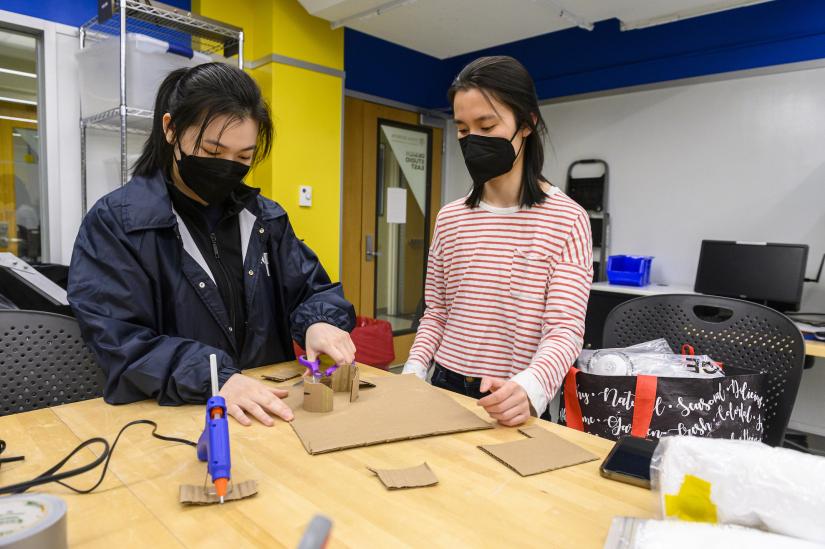- Name
- Jason Lucas
- jlucas27@jhu.edu
- Cell phone
- 443-301-7993
Three Johns Hopkins University undergraduates who developed a simpler and more comfortable brace to treat kids born with clubfoot, are among the finalists in a national competition for collegiate inventors.
The Dynamic Brace is shaped like a sock and made of light plastic. Since children with the condition must wear a brace for all or most of the day, until around the age of five, to reposition their misshapen feet, having a brace that feels good and is easy to get on can make a world of difference for families.

Image caption: From left, Delphine Tan, Jenlu Pagnotta, and Hannah Yamagata
Image credit: National Inventors Hall of Fame
"We wanted to create a brace that's significantly lighter and softer than the braces that are currently available to make it a more comfortable experience for kids," said Jenlu Pagnotta, who graduated in May with a degree in Chemical and Biomolecular Engineering.
To apply the brace, caregivers wrap it around the child's foot and align it into the correct position. Then using a coordinating handheld pump, polystyrene beads inside the fabric compress to hold the foot in place like a cast. The brace comes off easily by releasing a valve so that the boot relaxes. Getting the boot on and off takes less than five minutes, compared to traditional boots where it can take as long as 15 minutes.
"The traditional treatment for clubfoot involves wearing boots connected together by a metal bar, a setup that helps the condition but makes it hard for children to get around," said senior Delphine Tan.

Image caption: Delphine Tan and Jenlu Pagnotta develop The Dynamic Brace during an engineering class.
Image credit: Will Kirk / Johns Hopkins University
The students developed the idea during an engineering design course.
"The student team spoke with several families that have children with clubfoot to gain a better understanding of the lives of people at the center of this design challenge," said the student's faculty mentor Alissa Burkholder Murphy, senior lecturer in the Center for Leadership Education and Mechanical Engineering. "The students kept the parents' desire for improved comfort for their kids top of mind as they developed a solution that meets a real need and is desirable."

Image caption: The Dynamic Brace and coordinating handheld pump.
Image credit: Jenlu Pagnotta, Delphine Tan, Hannah Yamagata/ Johns Hopkins University
Families told the students they've spent a lot of money on doctors' appointments for boot fittings and replacing the boots each time their child's foot grows. This motivated the student team to design a solution to accommodate multiple foot sizes.
"It was important for us to help reduce the burden on families," said senior Hannah Yamagata.
The students are considering pursing a patent.
"I never thought a brace that is even remotely lightweight would be available for children with clubfoot," said parent Natalie Strobach. "The fact that the brace won't require kids' feet to be connected is a big deal."
The students will present their invention Oct. 12 to a panel of judges from the National Inventors Hall of Fame Inductees and the United States Patent and Trademark Office. Winners will be announced Oct. 13.
Johns Hopkins has had finalists or winners 38 times in the annual competition, which was founded by the National Inventors Hall of Fame to encourage innovation and entrepreneurship at the collegiate level.
Posted in Science+Technology, Student Life, Alumni







